- Home
- Deborah Harkness
The World of All Souls Page 44
The World of All Souls Read online
Page 44
Despite Matthew’s scolding, Queen Elizabeth did not give up her candied violets. Paul Hentzer, a German who traveled to London in 1598, described the ill effects of candy on Queen Elizabeth’s dental hygiene: “Her face oblong, fair but wrinkled, her eyes small, yet black and pleasant, her nose a little hooked, her lips narrow and her teeth black (a defect the English seem subject to, from their too great use of sugar).” Indeed, overindulgence in sugar became a mark of wealth, as did its consequent problems, including dental decay. It was the fashion for a time during Elizabeth’s rule for ladies to blacken their own teeth as a mark of their gentility and rank, as this gave them the appearance of having consumed a great deal of sugar themselves.
Here’s a modern recipe for candied violets (just don’t overindulge as Elizabeth I did):
Candied Violets
INGREDIENTS
2 egg whites
Superfine (caster) sugar
1 large bunch wild violets, including stems for ease of handling, washed gently in a colander or sieve and allowed to dry
DIRECTIONS
In a medium-size bowl, allow the egg whites to come to room temperature, then beat with a wire whisk just until frothy.
Place the sugar in another bowl. Taking one violet at a time, pick it up by the stem and dip into the egg whites, covering all surfaces of the flower. Gently dip into the sugar, again being sure that all the petals, both tops and bottoms, are covered.
Place on baking parchment or wax-paper-lined baking sheets; snip off the stems.
Using a toothpick, open the petals to their original shapes. Sprinkle sugar on any uncoated areas. Dry in an oven at 400 degrees F/200 degrees C/Gas Mark 6 for 30–40 minutes, or until sugar crystallizes. With a spatula or a two-tined fork, gently remove the violets to wire racks. Sprinkle them again with sugar if the violets appear wet or syrupy. Cool. Store in airtight containers with wax paper between the layers. Keep cool and out of direct sunlight.
Note: The recipe calls for using the common wild purple violet, not the African violet (often grown as a houseplant). And remember to brush your teeth and floss daily.
(This recipe was adapted from Taste of Home, February/March 1993.)
Wine
Matthew’s Wine Cellar
Vampires love wine. Given their bottomless bank accounts and the years they’ve devoted to collecting great bottles from the world’s best producers, it’s no surprise that they have terrific cellars. Sparkling, white, red, or fortified—all wine is fascinating to vampires thanks to their long memories and preternatural palates. Here are a few of the wines Matthew has stashed away:
SPARKLING WINE
1953 Diebolt-Vallois Champagne Brut Blanc de Blancs
1959 Billecart-Salmon Cuvée Nicholas-François
1961 Dom Pérignon
1979 Roederer Cristal
1982 Philipponnat Clos des Goisses
1989 Roederer Cristal
1990 Krug
1996 Krug Clos du Mesnil
WHITE WINE (DRY AND SWEET)
1811 Château Yquem
1847 Château Yquem
1862 Schloss Johannisberger Riesling Goldblaulack Auslese
1865 Hugel Tokay d’Alsace
1911 Erbacher Marcobrunn Riesling Trockenbeerenauslese
1921 Château Yquem
1944 M. Chapoutier Hermitage Blanc Chante-Alouette
1947 Le Haut Lieu Moelleux Vouvray, S.A. Huet
1949 Château Climens Sauternes-Barsac
1976 Bonneau du Martray Corton-Charlemagne
1976 Moulin Touchais
1978 Domaine de la Romanée-Conti Montrachet
1978 Domaine Jean-Louis Chave Hermitage Blanc
1991 Domaine de la Romanée-Conti Montrachet
1996 Château Haut-Brion Blanc
RED WINE
1825 Château La Nerthe
1865 Château Lafite Rothschild
1870 Château Lafite Rothschild
1899 Petrus
1900 Château Margaux
1921 Domaine de la Romanée-Conti, Romanée-Conti
1921 Château Cheval Blanc
1929 Clos Vougeout
1937 Château Ausone
1945 Château Mouton-Rothschild
1945 Domaine de la Romanée-Conti Romanée-Conti
1946 Beaulieu Vineyard Pinot Noir
1947 Château Cheval Blanc
1947 Beaulieu Vineyard Georges de Latour Cabernet Sauvignon
1949 Château Latour
1949 Paul Jaboulet Aîné Hermitage La Chapelle
1952 Château Ausone
1956 Charles Krug Vintage Selection Napa Valley Cabernet Sauvignon
1959 Domaine de la Romanée-Conti, Richebourg
1959 Château Lafite Rothschild
1959 Château Haut-Brion
1959 Domaine de la Romanée-Conti, Romanée Saint-Vivant
1961 Château Latour
1961 Château Lynch-Bages
1962 Penfolds Bin 60A
1964 Vega Sicilia Único
1966 Domaine de la Romanée-Conti, La Tâche
1968 Nathan Fay’s “Homemade” Cabernet Sauvignon
1973 Stag’s Leap Wine Cellars Cabernet Sauvignon SLV [Stag’s Leap Vineyards]
1976 Domaine de la Romanée-Conti Romanée Saint-Vivant
1976 Penfolds Grange
1978 Château de Beaucastel Châteauneuf-du-Pape
1978 Domaine de la Romanée-Conti, La Tâche
1978 Domaine de la Romanée-Conti Romanée-Conti
1978 Château Montelena Cabernet Sauvignon
1979 Ridge York Creek Zinfandel
1982 Château Pichon Longueville Comtesse de Lalande
1982 Petrus
1985 Domaine de la Romanée-Conti Romanée-Conti
1985 Tenuta San Guido Sassicaia Bolgheri
1989 Petrus
1989 Au Bon Climat Benedict Vineyard Pinot Noir
1990 Petrus
1990 E. Guigal La Turque Côte-Rôtie
1991 Château Cheval Blanc
1991 Qupé Syrah
1998 Château Petrus
OTHER FORTIFIED AND DESSERT WINES
1795 Henriques & Henriques Madeira Malmsey
1862 H.M. Borges Terrantez Madeira
1905 Pérez Barquero Solera
1905 Pedro Ximenez
1914 Cossart Gordon Bual Madeira
1927 Fonseca Vintage Port
1931 Quinta do Noval Nacional Vintage Port
1933 Justino Henriques Malmsey Madeira
1974 Heitz Cellar Angelica
Matthew’s favorite wines are Côte-Rôtie, including the 1990 E. Guigal La Turque Côte-Rôtie in his own wine cellar. It is a chewy, meaty wine that tastes of bacon and coffee, with lighter notes of raspberry and even floral accents—the perfect wine for a vampire’s palate!
Diana served Matthew a Côte-Rôtie at the first meal she made for him, to his immense delight. He could identify the wine by its scent because he recognized the aroma of the land—indeed, he knew the exact vineyard—where its grapes had grown. This wine comes from the South of France, near enough to Sept-Tours that both Matthew and Côte-Rôtie hail from the same region.
Côte-Rôtie is a red wine pressed from Syrah grapes grown on extremely steep, south-facing, rocky hillsides along the Rhône River. Many of these vineyards are planted in narrow terraces because the slopes are too steep to plant directly, making the vines particularly challenging and laborious to grow, tend, and harvest. These slopes give the wine its name: côte rôtie translates as “roasted coast” in English. The sun-warmed rocky hills allow the grapes to ripen despite the rela
tive cold of the area, and the minerals from the stony soil give the wine its unique character.
Grapes have been grown on the slopes of the Rhône for thousands of years. During the sixth century, Romans and Greeks lauded the wines grown here, and between the thirteen and nineteenth centuries, Côte-Rôtie was immensely popular among the nobility of Europe and Russia. Unfortunately, many of these vineyards fell into disrepair after the world wars of the twentieth century. But they are slowly being revived, and it is again possible for Matthew to obtain a wine bottled from the grapes of a steeply pitched, rock-ribbed vineyard he has known for centuries.
All Souls Trilogy Wine Tasting
Casa Belfi NV Prosecco “ColFondo”
Where? Vento, northeast Italy (DOC Prosecco)
What? A sparkling wine produced using the grape variety Glera in the “col fondo” method—primary fermentation finishes in the bottle
Who? Casa Belfi is an organic estate that works very naturally in the cellar to produce a Prosecco with fantastic personality and thirst-quenching ability
Tasting notes Citrus, flowers, bakery—hunger inducing
Les Champs Libres 2013 Lard des Choix Blanc
Where? Ardéche, Rhône Valley, France
What? A vin de table, or good basic food wine, made by two natural wine legends using 100 percent Grenache Blanc
Who? René Jean Dard and Hervé Souhaut buy organic fruit and craft humble, natural wines using a very simple method.
Tasting notes Flora, soft melon fruit, well structured (good balance)
Domaine Bruno Lupin 2013 Fousette de Savoie Frangy
Where? Savoie, eastern France
What? Fresh, clean white wine made from Rousette (altesse) in the cru Frangy. Alpine wine
Who? Made by Bruno Lupin in the hills of the Savoie with a relatively natural approach
Tasting notes Clean lines, pear fruits and soft mouthfeel
Domaine Jean Maupertuis 2013 Les Pierres Noires
Where? Auvergne, central France
What? A no-sulfur Gamay D’Auvergne made from grapes grown on volcanic basalt—supernatural wine!
Who? Jean Maupertuis makes incredible natural wine from biodynamic fruit with no additives
Tasting notes Smells of the farm: wild herbs, organic soil; sour cherries and gravel texture
Domaine Jean-Baptiste Senat 2012 Minervois La Nine
Where? Minervois, Languedoc-Rousillon, southern France
What? A blend of sunshine grapes (Grenache, Carignan, Cinsault, Mouvedre, Syrah)
Who? Jean-Baptiste Sénat grows organic grapes in the Minervois on limestone and clay soils and practices minimal-intervention winemaking
Tasting notes Power and warmth (from ripe grapes!), berries gently stewed in spices
Tea
Diana’s Favorite Tea
Tea is a central part of Diana’s life. For her it is a breakfast necessity, a treat at the end of a long day, a calming agent, a cherished weekend ritual—and on one memorable occasion, a means to wash the taste of witchwater out of her mouth. She loves the traditional black English and Scottish breakfast teas that are high in caffeine and designed to accompany a hearty meal. Diana prepares such tea with “precisely half a teaspoon of sugar and half a cup of milk . . . black as tar, a hint of sugar to cut the edge off the bitterness, then enough milk to make it look less like stew.”
Diana’s favorite tea, however, is a green variety from Mariage Frères, the French gourmet-tea company founded by the brothers Henri and Edouard Mariage in 1854. Green tea comes from the same leaves as black tea but is not fermented, which preserves its antioxidant powers. After Diana fends Matthew off with witchwind for the first time, he brews a cup of her favorite, Thé des Impressionnistes. According to Mariage Frères, “In the wild, rocky, maritime region of Provence in southern France, nature’s shimmering colors create rare and intense harmonies that delighted Impressionist artists. This green tea, scented with mild spices and white flowers, is also dotted with mauve flowers as a visual echo of the dazzling and powerful fragrance that fills the mouth.” It has a lovely scent of vanilla and flowers. And for a tea that smells like Matthew, try Alexandra David-Néel Tea by Mariage Frères.
Matthew makes sure that wherever she is, Diana has the tea she needs. As we know, wine rather than tea is Matthew’s drink. His passion and Diana’s are related, however. Tea is like wine in that its taste is greatly affected by the climate, the altitude of the plants, and the soil, not to mention the practices of the tea maker, who decides when to harvest the crop and how to process and blend it. Both drinks carry within them a history, which is important to vampires and historians.
All Souls Herbal Teas
Strictly speaking, tea refers to a drink made from the Camellia sinensis plant, which thrives in the high mountain regions of central China and Japan. The English did not really begin drinking tea until the seventeenth century, so in the sixteenth century Diana had to make do with so-called herbal tea, also known as tisane. This is not made of tea leaves at all but of dried herbs, flowers, seeds, roots, and/or fruits steeped in boiling water.
The most notable tisane that Diana drank was a contraceptive brew introduced to her by Marthe on Diana’s first visit to Sept-Tours. Marthe instinctively felt that Diana and Matthew were capable of having children and was worried about possible repercussions from the Congregation. Marthe’s tea (not to be re-created at home!) contains parsley, ginger, feverfew, rosemary, sage, Queen Anne’s lace seeds, mugwort, pennyroyal, angelica, rue, tansy, and juniper root. Many of these plants have been used since ancient times to prevent pregnancy; Hippocrates described the use of Queen Anne’s lace seeds over two thousand years ago. Some of the ingredients are intended to stimulate menstrual flow; others are supposed to prevent implantation of the egg; while others are abortifacients. Diana had to learn to identify these substances by smell as well as by appearance, presumably because similar-looking plants can be toxic! Marthe instructed Diana to fill the tea bags one at a time with a pinch of each ingredient, to make sure each bag contained all twelve. “Normally I didn’t like herbal tea, but this one was fresh and slightly bitter.” As Sarah pointed out, this is not a contraceptive method you’d want to rely on.
Among the tisanes that Diana drank in the sixteenth century were a warm brew made from mint and lemon balm, as well as Susanna Norman’s tisane of mint, chamomile, angelica, and some stiff, glossy leaves that Diana can’t identify. Back in the present but avoiding caffeine because of her pregnancy, Diana drank peppermint tea at the New Haven Lawn Club.
If you want to try preparing your own herbal tea, WebMD offers some suggestions: www.webmd.com/food-recipes/homemade-herbal-tea.
Here is an unbelievably delicious tea that Diana does not drink but I do: Turkish apple tea. You can find it online or follow this easy recipe: www.food.com/recipe/turkish-apple-tea-382701.
Also, while on tour for The Book of Life, I developed a disastrous case of laryngitis. I saw a doctor and rested my voice as much as possible, but the most helpful recommendation was from a Moroccan friend who supplied me with pots and pots of this stuff in Philadelphia so that I could whisper my hellos to you. Thank you, Hachim!
Hachim’s Mother’s Sore-Throat Tea
Fill a muslin tea bag with equal parts of fresh lemon verbena leaves and chamomile flowers.
Slice or cube about an inch of peeled fresh ginger.
Add 8 green cardamom pods, 8 cloves, 2 black peppercorns, 1 star anise.
Steep in 12 ounces hot water for about 3 minutes.
Add honey to taste.
Herbs and Medicinals
Marthe’s and Sarah’s Herbs
Marthe and Sarah each has a stillroom—short for “distillery room”—filled with pots and jars of herbs. Though Marthe is not a witch, she has been a cook for centuries, and she performs the role of family healer just as any wife or cook
in a large medieval household would. Both vampire and witch have a stillroom, which could be found in most castles and great houses in Europe beginning in medieval times. This is where herbs and flowers from the kitchen garden were dried and stored, where soap and other household cleaning products were made, and herbal medicines were concocted. In the sixteenth century, Marthe’s stillroom contained earthenware pots in neat rows on shelves, with drying herbs hanging from the rafters. Long before she met Diana, Marthe stored ingredients for contraceptive tea in a simple wooden box. The stillroom is women’s territory; men are strictly forbidden.
Marthe’s knowledge of herbs is surprisingly similar to Sarah’s. When Diana drank her “very own herbal tea” from Marthe, Sarah immediately recognized that it was actually a collection of contraceptive agents. Sarah’s own stillroom was once the farmhouse’s kitchen. Unlike Marthe, who as a vampire is slow to take up new ways, Sarah makes concessions to the twentieth century by using a seventies-era avocado-green slow cooker, a coffeemaker, an electric coffee grinder, and a blender to create her potions. As in Marthe’s stillroom, dried herbs and flowers hang between the exposed rafters: nigella pods, milk thistle, long-stemmed mullein, stalks of fennel, rue, feverfew. Though Sarah is untidy everywhere else, in the stillroom she keeps her Mason jars in neat rows on shelves and she labels wooden drawers with their contents. The herbs are not labeled alphabetically, but Diana feels sure that their placement is governed by some “witchy principle.”
Sarah also has a small teaching garden where she instructs the children of the Madison coven on the elemental associations of various flowers, plants, and herbs.

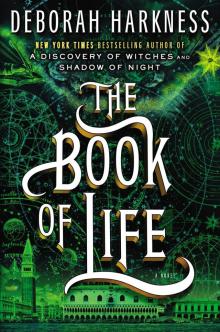 The Book of Life
The Book of Life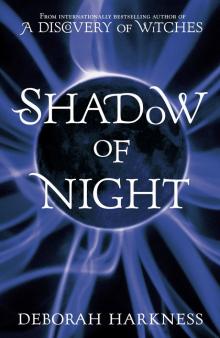 Shadow of Night
Shadow of Night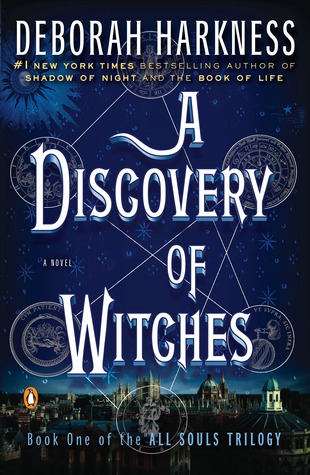 A Discovery of Witches
A Discovery of Witches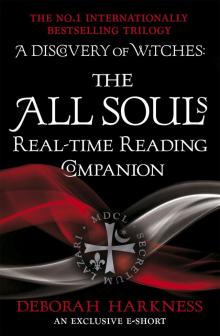 The All Souls Real-Time Reading Companion
The All Souls Real-Time Reading Companion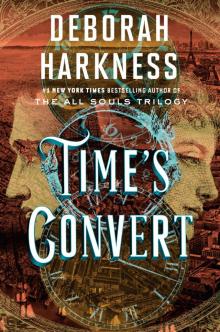 Time's Convert
Time's Convert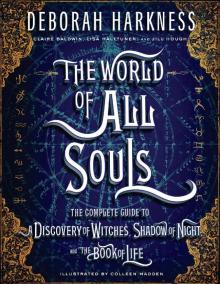 The World of All Souls
The World of All Souls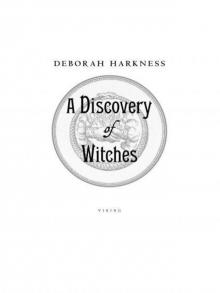 A Discovery of Witches: A Novel (All Souls Trilogy)
A Discovery of Witches: A Novel (All Souls Trilogy) Shadow of Night: A Novel
Shadow of Night: A Novel